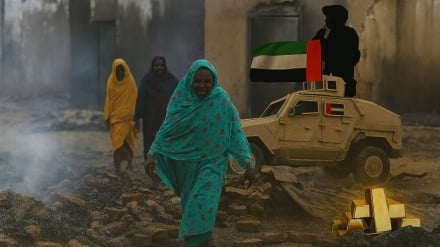Street artist captures Sudan’s slain protesters
The reign terror unleashed in Sudan by dictator Omar al-Bashir has led to the killing of countless peaceful protestors and despite the efforts of the regime to impose a news blackout, both the people of Sudan and the outside world are becoming aware of the alarming situation in that Arab-African country.
Here we present you a report from Khartoum by Jenny Gustafsson, titled: “Street artist captures Sudan’s slain protesters”.
Artist Assil Diab seeks to memorialize victims of deadly government crackdown in Sudan. It is early evening in a residential neighborhood on the outskirts of Khartoum, not far from the river Nile. The buildings are low, the streets covered in sand. The silence is broken only by the sound of a spray can being shaken.
Assil Diab, standing in front of a two-story building, sprays quick strokes to form the contours of a face, with short hair and soft eyes behind a pair of glasses. It belongs to Saleh Abdelwahab Saleh, the son of a family living in the building, and the portrait is a commemoration of his death. Saleh is one of more than 50 people who have been killed in Sudan’s anti-government demonstrations.
Diab, a Sudanese female street artist living in Qatar, said: “I do this to make people remember. This is not like an artwork hanging in someone’s house. If you walk by you will see it, you will speak about it and you will remember.”
Diab traveled to Khartoum a month ago, and since then has gone from house to house of those killed in the protests, met with their families and painted their portraits on the walls.
She said: “When I saw what was happening here I knew immediately that I had to get involved somehow. So I did what I do best, which is graffiti.”
Diab takes a step back to look at the portrait from a distance, then goes back to continue. She started when the sun was up; now, two hours later, the sky is pitch dark. Only a large spotlight on the ground lights up the wall.
Behind her, a small crowd has gathered. The family has brought out chairs, and sit in silence while she paints. Saleh’s father is here, wearing a plain white Sudanese robe, as is his elder sister, who raised all the siblings after their mother passed away a long time ago. His two brothers, both younger, lean against a parked car.
Says Alaa Saleh, one of the brothers “We were with him when he was killed. We had gone together to the demonstrations, it was the third time we all went. They just shot him right there in the street.”
The people of Sudan are rising up against the reign of terror of the Saudi-supported dictator Omar al-Bashir.
Initially starting in the northern town of Atbara in mid-December, the uprising spread quickly across the rest of Sudan. The igniting spark was a cut in subsidies that tripled the price of bread, but the underlying causes ran much deeper. Sudan had seen an economic crisis building up for years, partly due to United States sanctions, in place since the 1990s, and more recently from the 2011 secession of South Sudan, which caused the country to lose nearly three-quarters of its oil reserves.
Omar al-Bashir, who has maintained a repressive form of divide-and-rule since taking power in a military coup in 1989, immediately employed his massive security apparatus against the protestors. The forces, including notorious hit squads known as “thatchers” after the stern British prime minister, Margaret Thatcher, who ruled from 1979 1990, have beaten, arrested and shot people in the streets. At least 50 people have died in different parts of the country, including a teacher tortured to death and a small child run over by a militia vehicle.
Diab keeps a list in her phone with the names of everyone who has been killed, along with photographs of their faces. She gets help from a small team, which came together to join her after she arrived in Sudan.
She says: “We didn’t know each other before, we all met now in the past few weeks. We came together just for this thing, to make an art revolution.”
Ahead of making each portrait, they work together to find the address of the family, and contact them to see if they want their son or daughter to be painted. Most agree, says Diab.
She added: “There was one father who refused. His son was only 14 years old and just thinking of his name brought everyone to tears. His death is causing the family so much stress and depression.”
Just off the main road leading through one of Khartoum’s northern neighborhoods lives another family, in a house behind a red metal gate. There is a small hole in the metal, just below waist height. It is where the bullet came in that killed Mouawia Bashir Khalil, a father of six, one month ago.
Rawda Yousif, a relative of Khalil’s who lives next door, said: “He had not even been to the protests, he was just coming back from prayers when he was killed.”
He added: “There were big demonstrations that day and they were throwing teargas into our house. People were fleeing for their lives, hiding anywhere they could. He was shot right here, just as he stepped in through the door.”
Khalil’s portrait is now painted on the building facing the gate, with bright eyes and a slight smile. Yousif stood watching in the doorway, along with Khalil’s wife and daughters, as Diab painted it.
She said: “He was a kind man, known by everyone in the neighborhood. He used to go fishing in the Nile, and always brought home fish for all of us.”
Diab has done 12 portraits so far, including one of Awadia Agaba, a woman who was shot by the police outside of her house in 2012, and Babiker Abdelhamid, a young doctor who was killed after having treated wounded protestors, on the same day as Khalil.
She concluded: “My initial goal was to do only three or four to be honest, if I could get away with them. But it keeps doubling now.”
AS/SS


